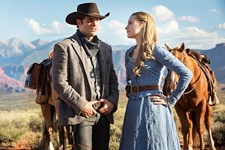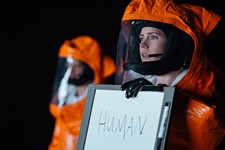Roar: The Blood Stays in the Picture
Star John Marshall on lions and the world's craziest home movie
By Richard Whittaker, 9:00AM, Wed. Apr. 29, 2015
John Marshall carries a stack of family photos: his dad, his brother, his dad's second wife, her daughter, the family's animals. That time one of those animals tried to eat them. The other dozen or so times that happened. After all, they were living and working in a house filled with lions.
The stack of 8x10s in Marshall's bag are behind-the-scenes shots from possibly the maddest home movie ever made: 1981's Roar, a berserk fever dream of a screwball comedy that almost had a body count. He said, "If you made a film today in California, like we did, if five people get hurt, they're going to shut you down, and you better have an explanation and investigations of why these people are going to the hospital. We had 70."
Marshall comes from Hollywood – if not royalty – then at least aristocracy. His father, Noel, was an agent, and an executive producer on The Exorcist. His second wife was longtime Hitchcock muse/victim Tippi Hedren, and that meant her daughter from her first marriage, Melanie Griffith was part of the extended Marshall family.
The idea for the film came about when Hedren and Noel Marshall were in Africa filming 1973's Mister Kingstreet's War, and they saw a pride of lions in an abandoned house. The script Marshall developed and directed put an American family (John, his brother Jerry, Hedren, and Griffith) in a house full of lions, tigers, panthers, and elephants, with Noel as the zany father who thinks this is a good idea. Unfortunately, nobody ever explained any of that to the 150 or so predators that ruled the roost.
Of course. Why wouldn't you make this film? After all, this was the era when Burt Reynolds was allowed to demolish a town for Hooper, Werner Herzog pulled a steamer across a mountain for Fitzcarraldo, and some maniac loaned Francis Ford Coppola the Filipino army for Apocalypse Now.
Roar has become a weird obsession: it plays like a family wilderness comedy, but it's very clear that this is a bunch of real people running from very real, and very dangerous animals. A minor success in Australia and England when originally released in 1981, it became a box office smash in Germany and Japan, where audiences embraced its dangerous insanity. After 34 years, it's finally getting a US release, courtesy of Drafthouse Films and Olive Films, with a limited (but ever expanding) theatrical run, and VOD and Blu-ray/DVD releases later this year.
For Marshall, it's not just a cult movie. It was his life, and he has the literal and metaphorical scars to prove it. "I went over just the immediate family, it was at least 14 [injuries], if not 17, in just the four or five of us."
Initially, he didn't know that the film was finally getting a long over-due US release. "My son is the one that told me about it," he said. "He says, 'Dad, Roar's coming out in theaters. Drafthouse is doing it.' I sent him an email back. 'What's a Drafthouse?'" Now he's in the middle, and he praises Drafthouse Films, and especially founder Tim League, for promoting it as what it really is - the most dangerous home movie ever. "Tim sees it it for what is," said Marshall.
He freely admits, it's a little intense for some viewers. A few years ago, he loaned a copy to an employee who was dating Renee Zellweger. "I asked him about a week later, what do you think of the storm? He says, 'most amazing film I've ever seen, more power to you.' What did Renee think? And he goes, 'she only watched about 15 or 20 minutes.' She thought it was that bad? 'No, she thought someone was going to die and she couldn't watch that.'
At a recent LA screening, the audience laughed solidly through the last 15 minutes of the film. When Marshall stood up for the Q&A, he recalled telling the crowd, "I gotta tell you, that last 15 minutes, with the family and the tigers and this and that and Mativo riding Boomer, and Tippi putting Buster on her, and all the cutesy shit? That shit was the easiest stuff to film. We could have done this movie for a million dollars and we could have filmed it in three months if you wanted that. It was all the other shit that took us five years and all that money and the accidents." His theory was simple: Audiences just aren't ready for the madness, and when it gets to the end, he told the crowd, "You were so happy that you didn't have a heart attack and nobody died."
Even he isn't immune. "It's just too intense," he said, admitting that he would wake up with cold sweats after re-watching the film. A few years ago, he and Hedren screened his 35mm print at New Line. They held hands for many scenes, and at certain points had to cover their ears, "It's like watching these ISIS things. We all know it happened to us."
Yet the whirlwind success, 24 years later, of the film has actually calmed some of that anxiety. Marshall said, "Ever since this mad thing started, I didn't sleep a week and a half, and finally I was desensitized."

Austin Chronicle: This is a crazy film to watch, but this was your life for years.
John Marshall: I ran a body shop before I moved out to the ranch, and then I devoted two years of prep. I ran the ranch, built it up, did all the shit, and then in the film I did a lot of different things. We'd start out in the morning and we'd go, Jan [de Bont, director of cinematography], how many cameras are you going to use? Well, five. I'd look at the crew and go, one, two, three, well, shit, we only have four camera operators, so if I wasn't in the shot I'd be a camera operator. Everybody had to be happy with a little bit of flexibility.
AC: There are some sequences - like the Preston Sturgess-style chase through the house - where you could change the music and have a horror film.
JM: I have a very large commercial production company, lot of great creative people, and somebody wanted me try it with hip-hop music, and I just couldn't envision it. But there was a director last week, a friend of mine, who said, you know, if you put scary, movie-horror music to that, that film would just kill. I thought about it, but that would be way too intense.
AC: There are points when you just go, that's a genuine scream, that's genuine blood. The accidents are there on the screen, and it's just a lion going, "I'm half a ton. If I decide to give you a nip, you're going to know about."
JM: They're wild animals.
AC: Did you ever go, "Dad, people don't need to see this, don't show that?"
JM: If you get bitten, at least you want to share it with people. There's one scene that was just too intense and we took it out in the version for England and Australia and what we thought would be the version for America. Dad's on the staircase and Mativo's drinking the Jack Daniels, and dad goes to get the glasses and he comes back. Donnie, this lion that used to try to bite me all the time, bit dad really deep. Dad let out a blood curdling scream, and Donnie yanked him off the stairs and started dragging him off to finish the job. Every animal trainer was dead scared of my dad because he'd yell at them. 'You've ruined the fucking shot! I'm not in danger!' I knew dad was in trouble, and I was the only one that stepped in, because I was the only one that stood up to him, so I saved his ass that day.
We left it in the German version. Now I'm not saying that's why the German version was number one, top grossing film there, but it was marketed much differently. I didn't follow it, and once I did England and Australia I ran away and continued with my new-found career. But I want to put that scene back there, because of the way Tim's marketing it, because that needs to be in there.

AC: When your father was trying to explain to you and the family and Jan what he was trying to do, what did he tell you?
JM: I don't think he really knew what he was trying to do. We knew that we were going to make this great film, and we would get to share our animals. We lived with these animals and we loved these animals, and we didn't ever, ever think that anybody would ever get bitten. That didn't enter into our mind, wasn't going to happen, because we thought that we were in control, and they respected us. You had to think that, because if it even crept into your subconscious, much less your consciousness, that you were a little afraid, you were dead meat. You can't show fear. You can bluff a lion, and you can scream at them and you can wave your arms, and you can scare the shit out of them, and we believed we wouldn't get hurt.
The problem, and I was the one that figured it out three months earlier than anybody else did, was that in the five years of prep where we raising these things, figuring out how to deal with them, you hit them on the nose and they respected us. The lion handlers would have a hog cane. If you break up lion fights, you use this stick. Now, my dad did it in the film, you use your hand, you get too close, you get bit. You use the stick, it's perfectly fine. But I figured out, well, wait a minute, when we start filming in a couple of months, I don't get this hog cane, and I don't get a chain and get to go catch them. I'm just going to be some actor, and I'm going to be acting afraid, and you shouldn't act afraid, and you shouldn't play hide and seek, and that's the plot of the movie.
So I said, well, shit, this is going to be a problem for me.
So I went to my two friends, the three of us were the main guys who handled the animals, and I said, I need you guys, every third day, somebody doesn't get a stick. They went, well, I'm not going in there without a stick. Well, if I have to go in without a stick for the nine months that we're going to film. I need you guys to alternate.
AC: So many people have concentrated on what was worst about the film, and the word insane has been thrown around so much. But what was the best thing about making it?
JM: My relationship with many of the animals. I had a tiger and a lion that were the end-all, be all. To have a 700-pound tiger love on me so much, he'd hear my voice, and it could be 110 degrees, and Siberian Tigers don't like that heat, but he'd come running up to me, and that is just so nice.
Somebody's talking me into a coffeetable book with the production stills, and I have so many amazing pictures and memories. It's the real life stuff. There are pictures of me with these little cubs, and it's just so special. I'm probably one of 20 people in the world that can say that and lived through it. I think it's stupid. I wouldn't let my children do it. I don't think anyone will do it again. But I don't regret a minute of it.
Roar from Drafthouse Films is in theaters now. read our full review here.
A note to readers: Bold and uncensored, The Austin Chronicle has been Austin’s independent news source for over 40 years, expressing the community’s political and environmental concerns and supporting its active cultural scene. Now more than ever, we need your support to continue supplying Austin with independent, free press. If real news is important to you, please consider making a donation of $5, $10 or whatever you can afford, to help keep our journalism on stands.
Richard Whittaker, Sept. 7, 2016
Richard Whittaker, Aug. 25, 2016
Richard Whittaker, Dec. 1, 2017
Richard Whittaker, Sept. 13, 2017
May 30, 2024
Drafthouse Films, Tim League, Roar, Tippe Hedren, John Marshall











